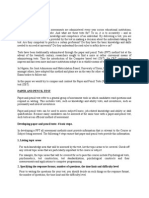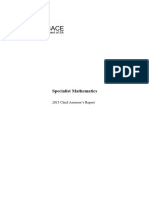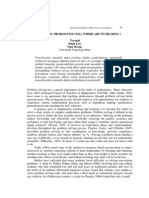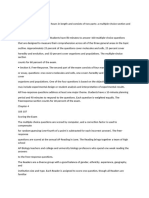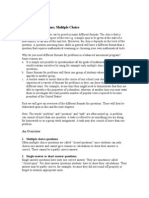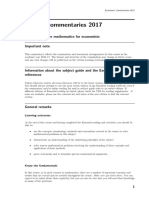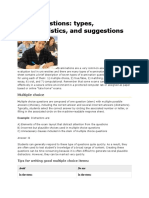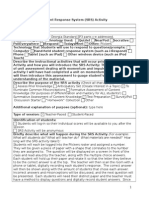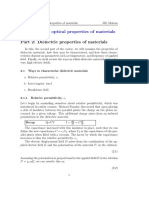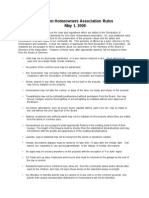Multiple-Choice Examination Papers at A Basic University Statistics Course. Experience Through 12 Years
Multiple-Choice Examination Papers at A Basic University Statistics Course. Experience Through 12 Years
Uploaded by
loveguy14322Copyright:
Available Formats
Multiple-Choice Examination Papers at A Basic University Statistics Course. Experience Through 12 Years
Multiple-Choice Examination Papers at A Basic University Statistics Course. Experience Through 12 Years
Uploaded by
loveguy14322Original Description:
Original Title
Copyright
Available Formats
Share this document
Did you find this document useful?
Is this content inappropriate?
Copyright:
Available Formats
Multiple-Choice Examination Papers at A Basic University Statistics Course. Experience Through 12 Years
Multiple-Choice Examination Papers at A Basic University Statistics Course. Experience Through 12 Years
Uploaded by
loveguy14322Copyright:
Available Formats
Multiple-choice Examination Papers at a Basic University
Statistics Course. Experience through 12 Years
Jon Stene
University of Copenhagen, Institute of Statistics,
Studiestræde 6,
DK-1455 Copenhagen K., Denmark
e-mail: usijs@pc.ibt.dk
Knut Conradsen
Technical University of Denmark , Institute of Mathematical Modelling,
Building 321, DTU,
DK-2800 Lyngby, Denmark
e-mail: kc@imm.dtu.dk
Examination papers form an important part in the evaluation of the students’
achievements of the educational goals of a course. Many basic courses with a large number of
students run into the problem that all students are not evaluated in the same way. Those evaluated
first may get a more thorough evaluation than those coming later. This is often the case with
written examination papers where all students are confronted with the same set of questions and
the examiners have to read through a large number of papers of 20 pages or more. Evaluation of
examination papers in this way also make a heavy demand on manpower.
Traditional examination papers in statistics courses in Danish universities tend to consist
of sets of two or three problems, each with a number of detailed questions. These problems are
taken from different areas in the course. Other areas are not considered at all, but the chosen areas
vary from set to set.This means that only limited areas of the course will be evaluated by each set.
The general knowledge of most areas of the course will not be tested at all at the same time.
At the Technical University of Denmark the basic course in statistics runs for about 15
weeks and is held twice a year. Often more than 400 students take the course. The course has run
for more than 25 years. The concerns mentioned above led in 1986 to the replacement of
traditional sets by sets of multiple choice questions, which has now been used 25 times.
The structure of the exam paper has remained almost the same during this period. A set
consists of a front page and of 30 questions starting at page 2 of the set. To each question 5
possible answers are given, only one being correct. In addition, there is a “don’t know” option.
The students are asked to mark one and only one of the 6 options and enter the answer into a box,
one for each question, on the front page. Only the front page with the student’s name and answers
is handed in and forms the basis for the evaluation. The answers are typed into a computer.
The questions vary quite a lot. Together they cover most of the topics in the course.
Some are theoretical ones where e.g. the expectation of a probability density has to be calculated,
5 options are given, only one being correct. Another example is different test statistics of a
contingency table each with a numerical value, significance level and critical region. Only one
among 5 options is correct. Some questions regard a recognition of the correct test for a given
data problem. For ANOVA problems different sums of squares are given and the students are
asked to choose the correct test statistic among 5 given ones. Some calculations are demanded,
but long calculations, e.g. of sums of squares are avoided. Much effort is put into making the 5
options quite distinct and unambiguous.
Five points are given for the correct answer to a question, a wrong one gets -1, and no
answer or “don’t know” gets 0. All questions are weighted equally. Evaluation is based on the
sum of points for each student. This sum ranges theoretically from -30 to 150. The observed sum
at an exam usually ranges from about nought to 150, which very few get. At the exam last autumn
the median sum was 72 and the quartiles 47 and 99, respectively. These three quantities may vary
considerably from term to term. One cause of variation is the person who constructs the set, who
has also run the course that term. The difficulty of the various questions and of the whole set
plays an important role. Young and less experienced teachers tend to construct more complicated
questions than more experienced ones. The external examiner has to accept the whole set. He has
been the same person for all these 25 sets and has played a modifying and homogenizing rôle. He
does not formulate the questions himself, but suggests revisions. Often substantial revisions are
made before a set is ready. A computer program calculates the sum for each student and a number
of summary results.
A difficult problem is to translate the sums of points to the scale of marks and, in
particular to determine the minimal number of points for passing the exam. In this connection one
has to consider the possibility that a student by pure guessing can obtain a sufficiently large sum
to pass the exam. As there are 5 options (except for the “don’t know” one) the probability for
guessing the right answer of a question is 0.2. By pure guessing the number of correct answers
is binomially distributed with binomial parameter 0.2 and counting parameter equal to the number
of questions considered, at most 30. If all 30 questions are answered, the probability for 9 correct
ones, giving the sum 24, is 0.129 and for 12 correct ones with sum 42 the probability is 0.009.
The sets vary so much from term to term that the minimum number of points for passing
cannot be kept constant. The same argument applies to the whole scale of marks. If the limits for
the different marks had been kept constant, the mark a student got, would depend heavily on the
term one entered for examination. Therefore, determination of these limits has been based on the
cumulative frequency function of the sum of points for the actual term. Several ideas have been
applied to determine the passing limit depending on how difficult the set has been. One regards
the percentage of students allowed to pass, which might be put to 70%. If this idea is applied
strictly and the set has been relatively simple some students, who have got a relatively large sum,
and hence attained many of the goals of the course, would fail. Therefore, this principle is
modified depending on the actual set. Similar arguments are applied for determining other limits.
The computer program also gives the percentage of answers to the six options for each
question. This gives the teachers and the text book author a very good feedback with regard to
problem areas in the course not fully understood and also with regard to the formulation of the
different questions and options. With 30 questions large parts of the course material can be
covered in a single set. In a set most of the questions should be so easy and straight forward that
more than 40% of the students get the correct answer, some questions should be so easy that more
than 70% of the answers are correct. Very few should be so difficult that less than 20% have
correct answer. Then the probability of a correct guess is higher.
FRENCH RESUMÉ
À l’examen écrit du cours élémentaire en statistique à l’École Polytechnique danoise
on pose une série de 30 questions à choix multiple. Seulement une possibilité est correcte. On fait
5 points pour une réponse correcte, -1 pour une réponse fautive et zéro pour aucune réponse. La
notation est basée sur la somme de points des étudiants. Les sujets des 30 questions couvrent la
matière du cours. Le type des questions varie beaucoup, quelques-unes sont théoretiques, des
autres traitent des applications et quelques-unes demandent des calculs numeriques. La
distribution de la somme varie d’un examen à un autre et depend du constructeur de la série des
questions. On discute des difficultés de la notation et de la composition de la série.
You might also like
- Paper and Pencil TestDocument9 pagesPaper and Pencil TestHamza Wiz-Ziboi Ibrahim75% (12)
- Paper and Pencil TestDocument8 pagesPaper and Pencil TestKrizna Dingding Dotillos100% (3)
- EMTL Unit Wise Question Bank UpdatedDocument13 pagesEMTL Unit Wise Question Bank Updatednitesh yasarlaNo ratings yet
- (Scale Modelling) - FAQ of The AFV Painting Techniques by Mig Jimenez PDFDocument221 pages(Scale Modelling) - FAQ of The AFV Painting Techniques by Mig Jimenez PDFnuckchorris201490% (10)
- Csat Jan 2011Document39 pagesCsat Jan 2011Dr. Vinod GuptaNo ratings yet
- Data Analysis No HeadingDocument5 pagesData Analysis No Headingapi-221681121No ratings yet
- Quantitative Probleme LösenDocument230 pagesQuantitative Probleme Lösenescarletapiam100% (1)
- How The SAT Is StructuredDocument7 pagesHow The SAT Is StructuredlookforwardNo ratings yet
- Formats For Problems Multiple Choice: An OverviewDocument7 pagesFormats For Problems Multiple Choice: An OverviewWijdan saleemNo ratings yet
- Sixth Term Examination Paper 2015Document5 pagesSixth Term Examination Paper 2015bsnyfpwgf100% (1)
- Language TestingDocument20 pagesLanguage Testingapi-337404580No ratings yet
- AdviceDocument5 pagesAdviceJaZz SFNo ratings yet
- Does Math Homework Improve Test ScoresDocument7 pagesDoes Math Homework Improve Test Scoresh3tdfrzv100% (1)
- Short Answer Question & MCQsDocument6 pagesShort Answer Question & MCQsVipul Prajapati75% (4)
- History Method Lecture 24 August Vce ScoringDocument4 pagesHistory Method Lecture 24 August Vce ScoringnamratashipstoneNo ratings yet
- (WWW - Entrance Exam - Net) GREDocument6 pages(WWW - Entrance Exam - Net) GRENimitesh SinghNo ratings yet
- Creating ExamsDocument6 pagesCreating ExamsBorn Campomanes LechugaNo ratings yet
- 2015 Specialist Mathematics Chief Assessor's ReportDocument9 pages2015 Specialist Mathematics Chief Assessor's Reportvokasa4037No ratings yet
- Scoring of Essay Type QuestionsDocument29 pagesScoring of Essay Type QuestionsSameena MagrayNo ratings yet
- Finale T.O.RDocument8 pagesFinale T.O.Raeroneantolin315No ratings yet
- Problem Solving and Mathematical Investigation and ModeingDocument4 pagesProblem Solving and Mathematical Investigation and ModeingNICSON SOREDANo ratings yet
- What Are Performance Tasks?: Christian Arturo WuDocument4 pagesWhat Are Performance Tasks?: Christian Arturo Wuapi-256128541No ratings yet
- Research PaperDocument7 pagesResearch Paperapi-378960179No ratings yet
- MATHEMATICAL PROBLEM SOLVING: WHERE ARE WE HEADING? by PARMJIT, SINGH LAU & NGEE KIONGDocument12 pagesMATHEMATICAL PROBLEM SOLVING: WHERE ARE WE HEADING? by PARMJIT, SINGH LAU & NGEE KIONGhas65No ratings yet
- Diagnostic TestingDocument8 pagesDiagnostic Testingmumarbsc7244No ratings yet
- Overview of The Digital SAT Math SegmentDocument2 pagesOverview of The Digital SAT Math Segmentisaacazad0033No ratings yet
- What Is Item Analysis?Document4 pagesWhat Is Item Analysis?matang_lawinNo ratings yet
- GRE Exam StructureDocument5 pagesGRE Exam StructureSaurabhNo ratings yet
- SBG ExplainedDocument3 pagesSBG ExplainedenzuberNo ratings yet
- Syllabus - Bafi 355.fall 2014Document4 pagesSyllabus - Bafi 355.fall 2014Aravind NairNo ratings yet
- 007 6qualitycriteriareviewform SarafriestDocument9 pages007 6qualitycriteriareviewform Sarafriestapi-252309040No ratings yet
- 8602 (2 Assignment) Samia Mumtaz 0000237743Document24 pages8602 (2 Assignment) Samia Mumtaz 0000237743jobshighlightsiteNo ratings yet
- TOP 5 STRANDS OF K-12 IN STDocument38 pagesTOP 5 STRANDS OF K-12 IN STJustine Vincent PascualNo ratings yet
- Econ 332 Economic Analysis of Labor Markets: Case Western Reserve UniversityDocument3 pagesEcon 332 Economic Analysis of Labor Markets: Case Western Reserve UniversityHiramCortezNo ratings yet
- Creating Exams: Choose Appropriate Item Types For Your ObjectivesDocument4 pagesCreating Exams: Choose Appropriate Item Types For Your ObjectivesGlenda Ortillano LeeNo ratings yet
- Dynamics Policy F18Document4 pagesDynamics Policy F18robinnew19No ratings yet
- Exam FormatDocument5 pagesExam FormatPkanNo ratings yet
- Teachers Comments On HomeworkDocument5 pagesTeachers Comments On Homeworkafnadyebqjzazl100% (1)
- TD - Edu HomeworkDocument5 pagesTD - Edu Homeworkerdqfsze100% (1)
- Introduction To Chemistry: Course # Chem 1010Document6 pagesIntroduction To Chemistry: Course # Chem 1010Jamal ShehuNo ratings yet
- TSA TipsDocument36 pagesTSA Tipsthe_ravster100% (2)
- Formats For Problems Multiple Choice: An OverviewDocument7 pagesFormats For Problems Multiple Choice: An OverviewHari RamNo ratings yet
- Homework Answer FreeDocument5 pagesHomework Answer Freecfhfp6dd100% (1)
- Chapter 3 Assessment ResearchDocument5 pagesChapter 3 Assessment ResearchTata Duero LachicaNo ratings yet
- Summary Essay Items..EditedDocument8 pagesSummary Essay Items..EditedJoboy FritzNo ratings yet
- Open Book ExamsDocument4 pagesOpen Book ExamsshoaybkhanNo ratings yet
- Further Mathematics 2017 Examiner's CommentaryDocument29 pagesFurther Mathematics 2017 Examiner's CommentaryRida FatimaNo ratings yet
- Exam Questions: Types, Characteristics, and Suggestions: Multiple ChoiceDocument6 pagesExam Questions: Types, Characteristics, and Suggestions: Multiple ChoiceDell MendozaNo ratings yet
- v2 Multiple Choice Tests Draft Jan 25 2019 SALTISEDocument19 pagesv2 Multiple Choice Tests Draft Jan 25 2019 SALTISEMANISH KUMAR SETHINo ratings yet
- Design For InstructionDocument12 pagesDesign For Instructionapi-267503852No ratings yet
- Mathematics Tests in Pisa 2003: © Tünde KDocument8 pagesMathematics Tests in Pisa 2003: © Tünde KMarcial HsNo ratings yet
- Gcse Maths Coursework Mark SchemeDocument6 pagesGcse Maths Coursework Mark Schemef60pk9dc100% (2)
- Part G Math Assessment CommentaryDocument8 pagesPart G Math Assessment Commentaryapi-25655052450% (4)
- Student Response and Assessment TemplateDocument3 pagesStudent Response and Assessment Templateapi-288315201No ratings yet
- GRE: What You Need to Know: An Introduction to the GRE Revised General TestFrom EverandGRE: What You Need to Know: An Introduction to the GRE Revised General TestRating: 5 out of 5 stars5/5 (2)
- Georgia's New Assessments: Parent Informational SessionDocument30 pagesGeorgia's New Assessments: Parent Informational SessionLynnSSkinnerNo ratings yet
- Taking SATDocument6 pagesTaking SATMotoveler PHNo ratings yet
- How To Prepare For Prelims (CSAT) : Paper 1 Is On General StudiesDocument31 pagesHow To Prepare For Prelims (CSAT) : Paper 1 Is On General Studiesanshu185No ratings yet
- IM3 Syllabus 2013-2014Document6 pagesIM3 Syllabus 2013-2014hmacdonald82No ratings yet
- Statistical Inference in Business 2013Document7 pagesStatistical Inference in Business 2013texifierNo ratings yet
- ParaPro Assessment Preparation 2023-2024: Study Guide with 300 Practice Questions and Answers for the ETS Praxis Test (Paraprofessional Exam Prep)From EverandParaPro Assessment Preparation 2023-2024: Study Guide with 300 Practice Questions and Answers for the ETS Praxis Test (Paraprofessional Exam Prep)No ratings yet
- Tumcos Consumer CaseDocument8 pagesTumcos Consumer CasesanjaytrustlawNo ratings yet
- Electrical and Optical Properties of MaterialsDocument18 pagesElectrical and Optical Properties of MaterialsRoy VeseyNo ratings yet
- Financial IntermediationDocument20 pagesFinancial IntermediationMusah HidirNo ratings yet
- Practice in Scanning and SkimmingDocument6 pagesPractice in Scanning and SkimmingZulfa Mahdiatur RNo ratings yet
- Temple of The Sphinx QueenDocument16 pagesTemple of The Sphinx QueenMason MartelNo ratings yet
- Erin Glen - Rules and Regulations - 2008 - 5-08Document2 pagesErin Glen - Rules and Regulations - 2008 - 5-08api-258394806No ratings yet
- JE, GL, TB - Mutual ServicesDocument17 pagesJE, GL, TB - Mutual ServicesJasmine Acta100% (1)
- Germany - Single GeoESP Offers Wider Operating Range Energy Savings at Half CostDocument2 pagesGermany - Single GeoESP Offers Wider Operating Range Energy Savings at Half CostAbdurabu AL-MontaserNo ratings yet
- New Phytologist - 2010 - OllingerDocument20 pagesNew Phytologist - 2010 - OllingerDébora PlácidoNo ratings yet
- Adrenergic Receptor Blocking AgentDocument2 pagesAdrenergic Receptor Blocking AgentLegendXNo ratings yet
- Summative Test Grade 7 TLEDocument3 pagesSummative Test Grade 7 TLEEdcelle SabanalNo ratings yet
- Segment Remapping With Load Database When Moving A DatabaseDocument31 pagesSegment Remapping With Load Database When Moving A DatabasezenglijunNo ratings yet
- English 2022 NIOS Class 10Document36 pagesEnglish 2022 NIOS Class 10Priyanka GuptaNo ratings yet
- Ujian s3 Section BDocument4 pagesUjian s3 Section Bshawl 1707No ratings yet
- I. State TRUE or FALSE To The Following StatementsDocument42 pagesI. State TRUE or FALSE To The Following StatementsKhant Si ThuNo ratings yet
- 156-315 80Document63 pages156-315 80Djambo MatamorosNo ratings yet
- The Role of Philippine CourtsDocument22 pagesThe Role of Philippine CourtsJoyan AggaraoNo ratings yet
- Chapter IDocument7 pagesChapter IKarlisNo ratings yet
- Cosh Session 2Document42 pagesCosh Session 2Andrea A. IgupNo ratings yet
- Lesson 1: MNS 1052 3-chiều thư năm. Cô Trinh. Team Code: t11m5ze doanvx@isvnu.vnDocument47 pagesLesson 1: MNS 1052 3-chiều thư năm. Cô Trinh. Team Code: t11m5ze doanvx@isvnu.vnHong NguyenNo ratings yet
- Ethics of String JournalismDocument25 pagesEthics of String JournalismTanvi SharmaNo ratings yet
- Ramdump Modem 2023-09-07 07-20-23 PropsDocument26 pagesRamdump Modem 2023-09-07 07-20-23 PropsIván Carrera YentzenNo ratings yet
- CC10 - Thomas Hardy's The Mayor of Casterbridge As A Late Victorian NovelDocument6 pagesCC10 - Thomas Hardy's The Mayor of Casterbridge As A Late Victorian NovelExoplasmic ReticulumNo ratings yet
- Life Sciences Grade 12 Informal Test GeneticsDocument4 pagesLife Sciences Grade 12 Informal Test GeneticsTonyy MichNo ratings yet
- Essay For CaeDocument14 pagesEssay For CaeSanti PoloNo ratings yet
- Public Perception On Cash Less Transactions in IndiaDocument16 pagesPublic Perception On Cash Less Transactions in IndiaMayukh BhattacharjeeNo ratings yet
- Project Report. - 080708Document43 pagesProject Report. - 080708alamigageraldjob33No ratings yet
- 6 Pavement Quality Concrete PPT by Deepak ThamanDocument6 pages6 Pavement Quality Concrete PPT by Deepak ThamanThaman Thaman100% (1)
